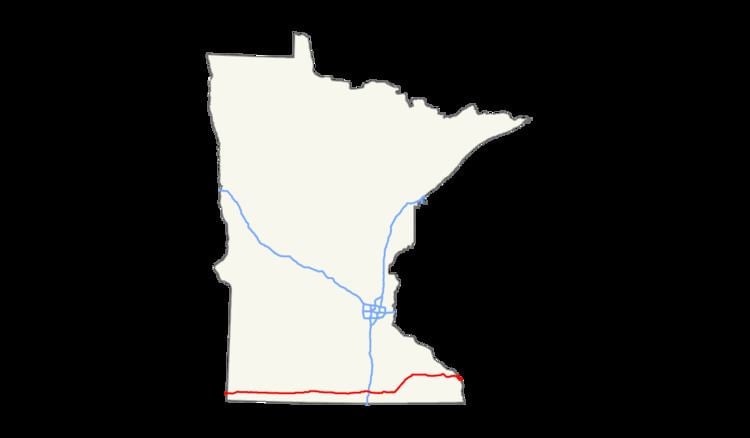Length 443.7 km | ||
 | ||
Counties | ||
In the U.S. state of Minnesota, Interstate 90 traverses the southern side of the state, parallel to the Minnesota-Iowa state line. The route connects the cities of Rochester, Worthington, Albert Lea, and Austin. The city of Winona is also in close proximity to I-90, with about 10 miles away separating the interstate and the city.
Contents
Interstate 90 in Minnesota is 276 miles (444 km) in length. The route crosses the far southern parts of the state.
Route description
Interstate 90 enters the state from South Dakota near Beaver Creek. This part of Minnesota has flat to gently rolling terrain and is the beginnings of corn belt farmland. The flat terrain is often subject to blowing and drifting snow in colder months, and the western portions of the highway are closed multiple times each winter.
Rock County, where I-90 enters Minnesota, is one of the only counties in the state lacking a natural lake. The change from semi-arid to a wetter climate happens slowly moving eastbound on I-90 through southern Minnesota. The route passes through the cities of Luverne, Adrian, Worthington, Jackson, Fairmont, and Blue Earth. I-90 has a junction with I-35 at Albert Lea.
East of the city of Austin, I-90 changes direction slightly and heads towards Rochester, and the route enters a much more hilly landscape. This is the driftless area of southeast Minnesota. Unlike the rest of the state, where the most recent glaciations left terrain that is either flat or rolling under a deposit of glacial till, this area escaped the most recent glaciation. The bedrock to the top of the I-90 road cuts is noticeable at this point. The other notable feature of this area are deep, steep valleys cut by water that poured through this area as the ice cap melted.
I-90 drops into the scenic Mississippi River valley just west of Dresbach. The I-90 freeway lanes split apart as you drop down, then rejoin west of the junction with U.S. Highway 61. I-90 then parallels the Mississippi River before turning east and crossing into Wisconsin.
I-90 is atypical in that just across the Minnesota / Wisconsin state line, (immediately west of the community of Dakota) the median is wide enough that farms exist between the road beds.
Legally, the Minnesota section of Interstate 90 is defined as unmarked Legislative Route 391 in the Minnesota Statutes. Interstate 90 is not marked with this legislative number along the actual highway.
History
Interstate 90 in Minnesota was authorized as part of the original interstate network in 1956. The first section of I-90 in Minnesota constructed was the bypass of Austin in 1961. The wayside rest area near Blue Earth, Minnesota, is where the east-building I-90 and west-building I-90 teams linked up in 1978, thus completing construction in Minnesota and joining the 3,099.07 miles of the interstate. Plaques dedicating the pavement completion and describing the significance of this segment are on display at the rest area.
I-90 in Minnesota closely follows the route of old U.S. Highway 16 over most of its route except from just east of Austin, where I-90 turns toward Rochester and is constructed on a new alignment not previously covered by a highway. The section of I-90 east of Rochester was constructed just south of U.S. Highway 14 and south of the city of Winona.
I-90 served as a replacement for old U.S. 16 between the South Dakota state line and I-90's interchange with present-day State Highway 16 at Dexter.
Future
A replacement of the I-90 Mississippi River Bridge near La Crescent is under construction. The new bridge is expected to be completed by November 2016.
